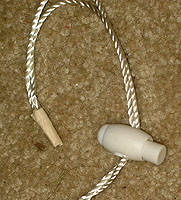In the steampunk world, I am Lucretia Strange, the Baroness Strange. I run the Promethean Society, and do a variety of presentations at steampunk conventions.
In the real world, I am Cassie Beyer and a historian with a blog, History, Interrupted, devoted to history, steampunk, costuming, popular culture and other eclectic interests.
You can best reach me through the Promethean Society or through Cassie@AlterEgoDesign.net. AlterEgo is my freelance web design endeavor focused on small businesses, individuals and organizations.
Hemming in a Drawstring
Drawstrings are the simplest way of making an opening (usually a waistband)
adjustable. There's two ways of doing this. First, you can simply hem the edge
and then inch your drawstring through the pocket of material created by the
hem. This, however, is tedious and sometimes difficult. If you've got a long
hem (and if we're working on a skirt, we could be talking 10 feet), that's
going to be a ton of work.
I suggest placing the drawstring inside the hem before sewing. Pin the material close to the drawstring, and then put your stitches on the other side of the pins. This helps to keep the drawstring from accidentally getting sewed, at which point it won't be able to function as a drawstring.

You'll also want to pin the drawstring at either end so that it doesn't get pulled inside the material, where you can't reach it. You can un-pin it when you're finished sewing.
Run both ends of the drawstring through a cord stop. You may need to tape the ends of the cord (as pictured) to get them through the cord stop. Then tie the ends of the cord together with a big enough knot that you cannot actually pull the cord stop off. The cord stop will allow you to tighten and loosen the drawstring as necessary for dressing.
